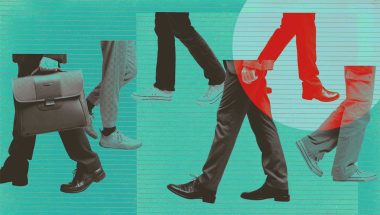- | 1:00 pm
Remote desk workers are in just as much danger of getting hurt on the job as industrial ones. Here’s what to do
Here’s what leaders of remote teams can learn from industrial safety programs.

We don’t typically associate remote work with the need for workplace safety programs. Employees are sitting in their living room or home office, not navigating manufacturing floors or distribution centers.
But here’s the reality: Remote desk workers are in just as much danger of developing debilitating musculoskeletal disorders (MSDs) as industrial workers. Poor posture, sustained position, and repetitive motion will cause injury regardless of whether an employee is operating heavy machinery or hunkered over a laptop at their kitchen table.
A 2020 study found that 40% of people developed new or worsened MSDs after they began working from home during the pandemic. Carpal tunnel syndrome, tendonitis, thoracic outlet syndrome, and tension neck syndrome are all common among desk workers.
The cutting-edge, AI-enabled solutions used on industrial work floors may not be practical on the same scale for remote desk workers—but many of the fundamental ergonomic theory and safety best practices on which that technology is based are very relevant.
Here’s what leaders of remote teams can learn from industrial safety programs.
REPETITIVE MOTION AND POOR POSTURE CAUSE INJURY
Industrial businesses have long battled musculoskeletal injuries in the workforce. According to the U.S. Bureau of Labor and Statistics, MSDs are the single largest category of workplace injuries and are responsible for nearly 30 percent of all workers’ compensation costs.
The problem isn’t necessarily heavy lifting or intense physical exertion. Simple but repetitive hand and wrist motions are often to blame. The act of rotating one’s wrist to fit together two components, when performed hundreds of times per day without adequate breaks, can squeeze off blood and lymphatic flow. Injuries resulting from repetitive tasks like hand-intensive work cost U.S. businesses more than $2 billion per year.
For desk workers, the problem is typically one of posture. To put our eyes closer to laptop screens, we tend to hunker over: shoulders forward, neck stooped, elbows leaning on the table in front of us. When held for long periods of time, this protracted position can limit the circulatory system, cutting off blood and lymph flow.
Blood brings in oxygen and nutrients, while lymph carries away waste and toxins. Without those vital processes, areas of the body partially cut off from circulation begin to break down. Thoracic outlet syndrome, for example, occurs when a small gap between muscle and bone at the base of the neck is condensed, clamping down on the brachial plexus nerve. Carpal tunnel syndrome, which affects an estimated 10% of office workers, can be caused by certain types of compressions higher up in the arm and neck or by repetitive forward and backward (flexion and extension) wrist movements. These movements compress the wrist (at the Flexor Retinaculum), which pinches the nerves going to the hand causing numbness, tingling and pain.
ERGONOMICS AND MICRO-STRETCHING ARE KEY TO INJURY PREVENTION
So how do manufacturing and distribution workplaces fight back against MSDs? By understanding and applying the ergonomics principles that keep workers safe.
That begins with training. Large manufacturing businesses invest time and resources into educating workers on how to keep themselves safe as they navigate the physical workplace. Employees performing hand-intensive tasks are often taught to keep their hands and wrists in a neutral position to maintain healthy circulation.
Managers of remote employees should be just as circumspect. Desk workers should be taught to maintain an upright posture through core strengthening and activation, with their shoulders dropped, their shoulder blades back slightly, and their elbows off the desk and below their hands.
Desk workers should also adopt the practice of micro-stretch breaks, which are used by industrial workplace safety programs to counter the prolonged postures and hand positions common with their workers. I recently worked with a large electrical engineering firm to implement such a program with their frontline workers. We set up regularly scheduled breaks throughout the day for workers to move through a series of diaphragmatic breathing exercises and neck, chest, and hand stretches. Not only did employees reduce their perceived level of tightness and pain by 38%, but every single participant noticed an improvement in range of motion in every joint within four weeks.
Remote workers can reap the same benefits. Taking just five 5-minute micro-stretch breaks throughout the day reverses the effects of protracted postures and opens up the proper flow of blood and lymphatics.
AI-ENABLED TECHNOLOGY CAN KEEP WORKERS SAFE
Of course, it’s one thing to ask employees to use proper form and take micro-stretch breaks. It’s another for them to follow through, which is why a personal app to track your own movements, along with other compliance measures, ensures engagement in manufacturing settings.
That’s even more of a problem in remote settings, where the employer has limited control over the physical workplace and can’t easily monitor whether an employee is using good form or breaking for micro-stretches. That’s no knock against remote workers: even with the best of intentions, it’s easy for safety compliance to break down during a busy day crowded with back-to-back meetings and pressing deadlines.
Here’s where technology can make the difference.
Industrial companies are now using AI-enabled wearable devices to identify worker movements and keep workers safe. A glove or hand wrap with a wearable sensor, for example, can provide a gentle buzz to notify a worker any time he or she compromises the recommended neutral hand position.
The data from these devices also provide visibility to the safety team, which receives customized reports on employee movement across teams and departments. If a segment of employees is showing a high rate of risky movement, the team can organize custom training sessions.
Similar products exist for desk workers. This technology empowers workers to understand when they’re slouching or remind them to take micro-stretch breaks. Best of all, because the device is measuring that individual’s movements, these recommendations are personalized for that worker’s unique physiology and circumstance.
Managers of remote teams may not have the budget to invest in such tools for the entire workforce. But strategic application might cut down costs while moving the needle on workplace safety. Businesses may send wearable devices to new employees to teach them safety best practices during onboarding.
Whether your team is manning a high-volume distribution center or Zooming in from home, investing in a workplace safety program shows that your business cares about their well-being. With remote work firmly established as the norm, companies need to get serious about protecting these employees from MSDs.
By deploying ergonomic best practices and cutting-edge technology, employers can help to improve employee safety, workplace satisfaction, and productivity.







































